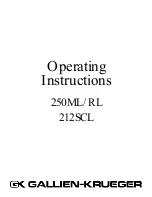
144
About dynamic modulation
(Dmod)
Dynamic modulation (Dmod) is a function that lets you
use MIDI messages or the TRITON STUDIO’s controllers
to control specific effect parameters in realtime.
BPM/MIDI Sync is another function that controls effect
parameters, and is used to synchronize the LFO speed of
modulation-type effects or the delay time etc. of delay-
type effects to the tempo of the arpeggiator or an external
sequencer.
For details on each of these functions, refer to PG p.246,
248.
Setting example:
We will show how you can use dynamic modulation to
control an effect parameter in realtime.
1
As described in the procedure for “Effect settings for
a program” (
p.140), set “IFX1” to 049: L/C/R BPM
Delay. Verify that a delay sound is being output.
2
Access the Program P8: Edit-Insert Effect, IFX1 page.
Using Dmod to change the delay level by moving
the joystick away from yourself
3
Set “Input Level Dmod” to +100.
4
Set “Src” to JS+Y: CC#01. The delay sound will disap-
pear.
The input level to the effect can be controlled by the
joystick. As you move the joystick away from yourself,
the delay sound will gradually increase.
Using Dmod to modify the feedback level from
[SW1] key
5
In P1: Edit-Basic, select the Controller Setup page,
and set the function of “SW1” to SW1 Mod.: CC#80
(Toggle).
6
Return to P8. Set “Feedback Src” to SW 1: CC#80.
7
Set “Amt” to +30.
When you (move the joystick away from yourself and)
press the [SW1] key, the feedback level will increase,
and the delay sound will continue for a longer time.
The “Amt” setting specifies the feedback level that will
be in effect when the [SW1] key is pressed. If “Amt” is
set to –10, pressing the SW1 key will reduce the feed-
back level to 0.
Using the BPM/MIDI Sync. function to synchronize
the delay time to arpeggiator tempo changes.
8
Set “BPM” to MIDI.
9
For L, C, and R, set “Delay Base Note” and “Times” as
desired.
For this example, set “Delay Base Note” to
and
“Times” to x1 so that the effect will be easily under-
standable. The delay time will repeat at an interval of a
8th note.
0
Rotate the [TEMPO] knob, and the delay time will
change.
When you (push the joystick away from yourself and)
press the [SW] key, the feedback level will rise, and the
delays will become longer.
A
When you turn on the ARPEGGIATOR [ON/OFF]
switch, the arpeggiator will begin playing.
Select any desired arpeggio pattern. When you rotate
the [TEMPO] knob, the delay time will change in syn-
chronization with the changing tempo of the arpeggio.
If you rotate the [TEMPO] knob to change the tempo
while the delay is sounding, noise may occur in the
delay sound. This is because the delay sound
becomes discontinuous, and is not a malfunction.
For some effects, you can synchronize the LFO fre-
quency to the tempo. Set the effect parameters
“BPM/MIDI Sync” to On, and “BPM” to MIDI. For
details refer to PG p.248.
Содержание sampler
Страница 1: ...1 E...
Страница 8: ...viii...
















































